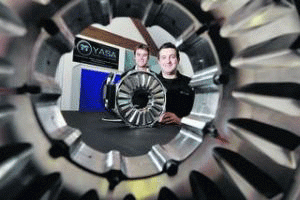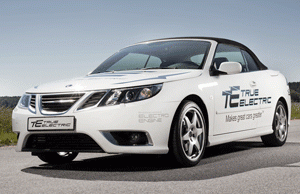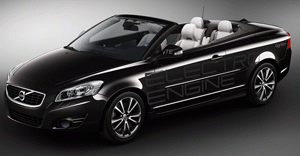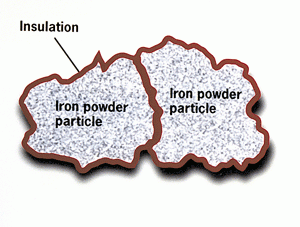PM used in ultra compact, high torque electric motors for direct drive automotive applications
Oxford YASA Motors Ltd is a rapidly growing young company born out of research carried out in recent years at the Engineering Department at Oxford University by Dr Malcolm McCulloch and Dr Tim Woolmer. The research involved the development of a permanent magnet synchronous motor based on ‘Yokeless and Segmented Armature’ (YASA®) topology to produce a new type of axial flux motor which shows a step change improvement in torque density and efficiency when compared with other axial flux motors.
Dr Woolmer, who is now Chief Technical Officer at the company’s headquarters in Abingdon, stated that the topology of the new ultra-compact motor is based around a series of magnetically separated segments that form the stator of the machine. The novel, ultra-compact motor design is made possible by the use of Somaloy grade SMC iron powders produced by Höganäs AB, Sweden.
Oxford YASA Motors was established in September 2009 and in little more than a year since the company started producing its novel electric motors, it has won prestigious awards from The Engineer and The Low Carbon Vehicle Programme (UK), and was highly commended in the Engineering Excellence Awards. Its commercial progress has seen the company’s shareholders committing a second tranche of funding (£1.45 million) to expand production capacity.
Nick Farrant, the company’s Chief Executive expects current production of 100-200 motors per year to increase to several thousand in the immediate years ahead. The company’s 5-year goal is to be producing 15,000 to 20,000 electric motors per year, stated Mr Farrant. This will come from increasing use of electric motors in motor racing applications – such as the Westfield IRacer car and TTXGP bike, as well as in EV and HEV family saloons and sports utility vehicles. The company is in collaboration with Delta Motorsport and Morgan Motor Cars in the UK, and also Electroengine AB in Sweden, the backer of Saab’s first electric car, recently presented at the Paris Motor Show.
Electroengine has also helped to transform a Volvo C70 into an all-electric car using either one YASA axial motor on each front wheel for direct drive or an electric motor on each of the four wheels for 4-wheel drive. The ‘True Electric C70’ was unveiled at the Electric Car Seminar held in Helsinborg, Sweden, in November 2010. It can accelerate up to 60 mph in less than 6 sec with a top speed of more than 125 mph and range of up to 200 miles. ‘This ‘blistering’ performance from an electric car is possible thanks to the 400 bhp available from the direct drive motors connected to all four wheels, which deliver a gut-wrenching 650 Nm of torque per wheel’ said Björn Karlström of Electroengine.
The heart of the YASA® electric motor
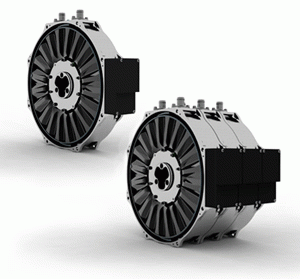
Axial flux motors built by Oxford YASA Motors Ltd
in Abingdon, UK for direct drive automotive
applications
Dr Woolmer stated that the concept of YASA® is to produce the highest torque density of any electrical machine currently on the market. Current best is said to offer between 10 and 20 Nm/kg, with YASA products in the region of 30 to 40 Nm/kg. Oxford YASA Motors currently has one product: a 750 Nm, 100 kW electric motor weighing 25 kg.
The electric motors can be used either as a pair fitted as the direct drive to two of the vehicle’s wheels, or four per vehicle for racing performance or 4WD function. The new topology of the YASA® axial flux motor was specifically designed for direct-drive traction and uses Somaloy 5P – the third generation of soft magnetic composite (SMC) iron powder developed by Höganäs AB, Sweden. SMC materials are basically iron powders separated with an electrically insulated layer, which can be processed by powder metallurgy into 3D-net shaped components, and are a cost efficient alternative to electrical steels in the low to medium frequency range applications.
The recently introduced Somaloy 5P iron powder material now used in the YASA® motors offers further improvements in purity and heat treatment temperature (650oC compared with 225oC for the 1st generation and 550oC for the 2nd generation of Somaloy grades). This allows a reduction in coercivity from 350 A/m to 120 A/m which together with an order of magnitude increase in resistivity has led to a 50% reduction in power losses.
Dr Woolmer reported that the iron used in the stator of the YASA® is dramatically reduced when compared to other axial flux motors, typically by 50% which causes an overall increase in torque density of around 20%. This has been achieved by removing the stator yoke to save weight and unnecessary iron losses, enlarging the pitch of the teeth so that their arc is similar to that of the magnets, and wrapping a winding around each of the individual teeth.
The result is an ultra-compact axial air gap motor suited to cost-efficient volume production giving a high power-to-weight ratio and 94% efficiency at normal operating speed. The modular design of the YASA® motor allows for stackability – up to four motors in parallel generates a power of 400 kW – and direct drive. The latter eliminates the need for costly and inefficient transmissions further reducing overall weight of the vehicle and cutting production and maintenance costs.
The actual power for the YASA® motors can be provided by a battery or a small hybrid engine with additional energy being captured using super-capacitors during braking. Oxford YASA Motors states that whilst the current technology makes for a relatively expensive motor, the scaling up into volume production will see the price of electric motors reduced to around £1000 each – cheaper than a conventional IC engine.
News | Articles | Market reviews | Search directory | Subscribe to e-newsletter
Pulished on www.ipmd.net
News, articles and a fully searchable directory for the powder metallurgy industry



